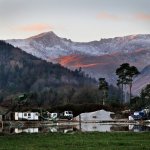I’ve been asked to write some words for Montage Press
A publication circulating Glasgow Film Festival 2011.
Hibernate In Arran : An Unmade Film
Chris Dooks
In December 2010, I asked my wife if she minded me nipping across the water to the Isle of Arran for a week where I’d make a kind of sound art / travelogue piece about our life. I’d split my time writing & recording odd observations and composing doggerel and music. All of this would be sprinkled over a slow-cooked stew of drones from contemplative record label, Hibernate Recordings.
I am pursuing a PhD which is (currently) entitled “The Emancipation of The Exhausted Artist” and I spend most of my time crawling around Ayrshire, attempting to evaluate which art projects can outfox my illness. The curious bio-squatter in question is Myalgic Encephalomyelitis (M.E.) – which despite rogering me of my film-making career for 13 years, has gradually forced me to be resourceful, cunning and maybe even a little tender towards the malady.
If I was healthier, I might be trying to make a feature film. However, all cultural projects made with M.E. end up being continually reduced in scale. It’s a humbling and humiliating experience at times. Adaptation is key for a film-maker who is too poorly to make films, so I frequently create isolated soundtracks which are lighter and more restful ‘films’. Hibernate in Arran is such a work, made as an attempt at a ‘cinema for the ears’.
Sound recordings or music that inspires imagery are nothing new. I remember at school studying ‘Tone Poems’ and Aaron Copland’s works such as Billy The Kid – classically ‘visual’ music – rather like Tex Avery’s Tom and Jerry scores. But it wasn’t until I heard the more religious sounding music of Ligeti, Arvo Part and Steve Reich that I felt my internal cinema really turned on. Do these composers affect the body more viscerally? Harmonic drones seem to have a profound biomusical affect on me, and drone-work is the musical theme of Hibernate.
If radio producers are aware of radio’s visual manifestation through unconscious audience ‘participation’, then there is potential for a kind of internal or ‘pensive’ cinema here. While I might do a bit of cooking whilst listening to a panel discussion, if I want to listen to a radio documentary, I’ll consciously limit my visual distractions to contemplate the images. Sometimes this happens automatically when good radio is playing, it can root me to the spot. If it’s really good, I might shut my eyes for the best pictures.
I’m not creating ‘straight’ documentary. The soundtracks I make aren’t isolated poetry readings, nor ‘pure’ music; but a whole collage of thematically connected fragments. I am calling these mixes Unmade Films where the listener ‘completes’ the visual aspect of a sound recording in their head. Convenient, huh? Cheap too!
But on reflection, I’ve never made ‘proper’ films – in 1997 I’d gotten a Scottish Screen grant to make one of their Prime Cuts series. It was called No One Sees Black – the only non-narrative film work to come from that stable. I gave them a hard time (and got one back) what with not having a script. I also made some TV arts documentaries for STV and The South Bank Show around this time. But reflecting on those works, I’ve only recently realised that most of them are about sound. Little did I know that I would be slowly wandering around Brodick, fifteen years later trying forge soundtracks for the head and, I hope, also for the heart.
If you’ve been moved to download ‘Hibernate in Arran’, you may do so here
You will need the password: ‘binary’
If you like it, you may wish to plumb other sonic depths here, where I will be your humble and grateful sonic stockbroker.
chris@dooks.org



